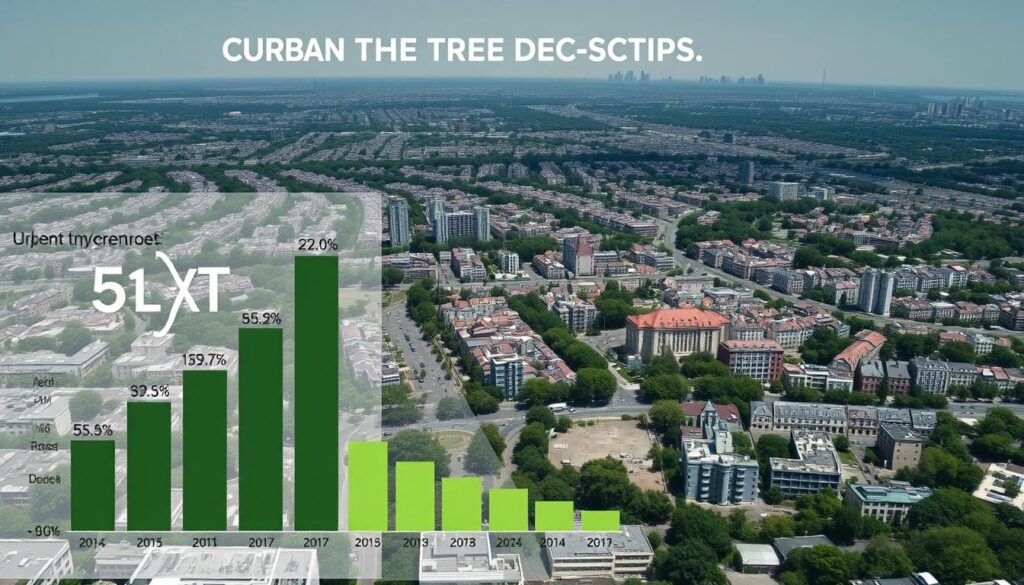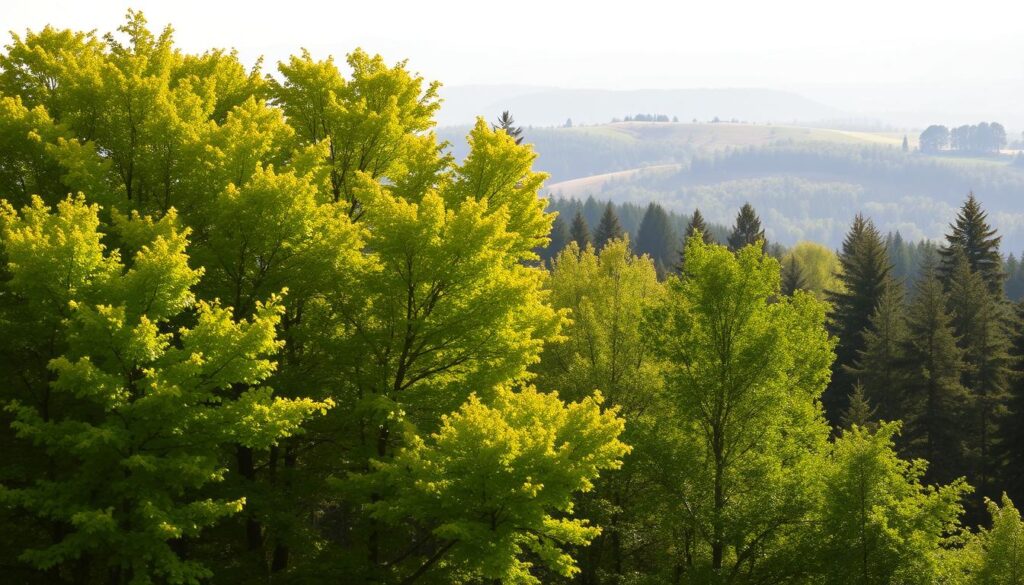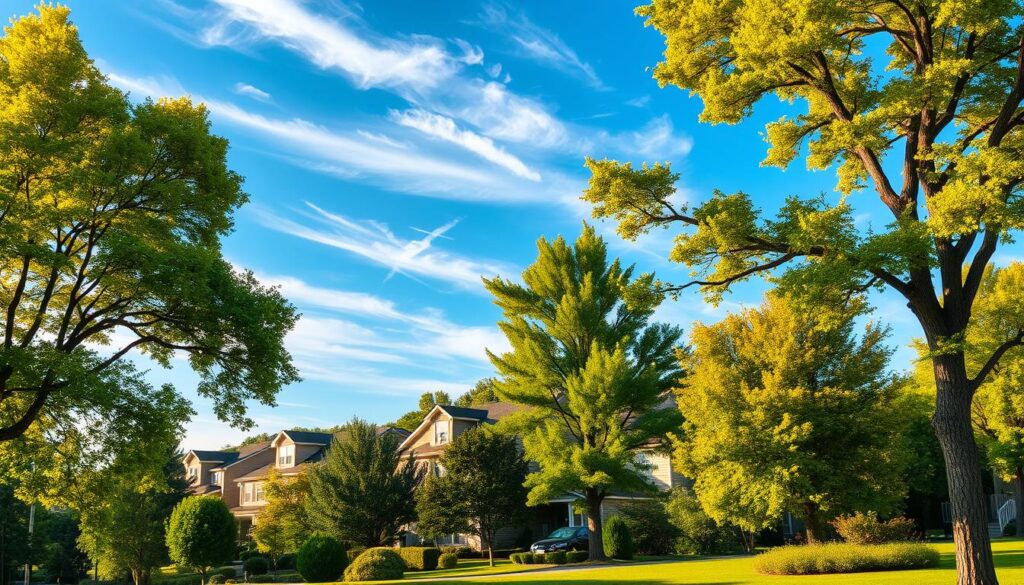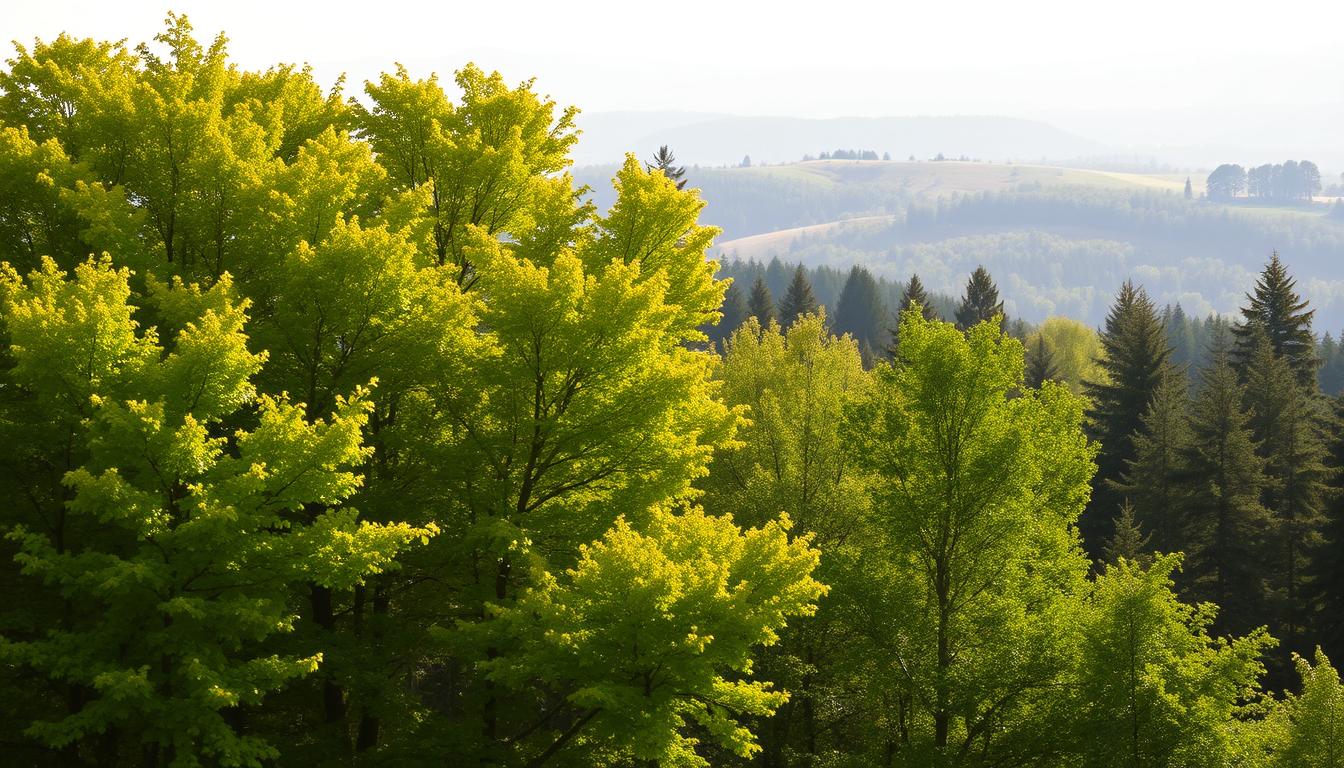How Many Trees Do You Need to Purify Air Around Your Home?
How Many Trees Do You Need to Purify Air Around Your Home?
Did you know that a single mature tree can absorb up to 48 pounds of carbon dioxide per year? With the average American home surrounded by numerous sources of pollution, having the right number of trees around your property can significantly improve air quality.
Air purification is a critical aspect of maintaining a healthy environment, and trees play a vital role in this process. By understanding the role trees play in purifying the air, you can take steps to create a healthier living space.
For a cleaner and healthier environment around your home, consider consulting with experts. Call 502-644-TREE for free bids on tree planting services tailored to your needs.
Key Takeaways
- One mature tree can absorb significant amounts of CO2 annually.
- Trees are crucial for improving air quality around homes.
- Professional tree planting services can help optimize air purification.
- Contacting experts can provide personalized solutions for your property.
- Free bids are available for tree planting services.
How Many Trees Do You Need to Purify Air Around Your Home?
The air inside your home may be more polluted than you think, according to recent findings. As you go about your daily life, you’re likely exposed to various pollutants that can affect your health and wellbeing. Ensuring good air quality is crucial for maintaining a healthy living environment.
Recent Studies on Indoor and Outdoor Air Pollution
Recent studies have shed light on the extent of air pollution both indoors and outdoors. These studies are crucial for understanding the scope of the problem and identifying potential solutions.
2023 EPA Air Quality Findings
The Environmental Protection Agency (EPA) released findings in 2023 that highlighted the prevalence of air pollutants in homes across the United States. Their research showed that indoor air can be 2-5 times more polluted than outdoor air, emphasizing the need for effective air purification methods.
How Many Trees Do You Need to Purify Air Around Your Home?
Local air quality challenges vary significantly across different regions. Factors such as geographical location, urbanization, and industrial activities contribute to these variations. Understanding these challenges is key to addressing them effectively.
Health Impacts of Poor Air Quality
Poor air quality has significant health implications, ranging from mild discomfort to serious health conditions. It’s essential to understand these impacts to appreciate the importance of air purification.
Respiratory Conditions Linked to Air Pollution
Air pollution is closely linked to various respiratory conditions, including asthma and chronic obstructive pulmonary disease (COPD). Reducing exposure to pollutants can significantly mitigate the risk of developing these conditions.
How Many Trees Do You Need to Purify Air Around Your Home?
Certain populations, such as children, the elderly, and those with pre-existing health conditions, are more vulnerable to the effects of poor air quality. Protecting these groups is a priority, and improving air quality is a critical step in doing so. For those looking to improve air quality around their homes, considering professional advice is a good start. You can call 502-644-TREE for free bids on tree planting services, a natural and effective way to enhance air quality.
Understanding How Trees Act as Natural Air Purifiers
Understanding how trees act as natural air purifiers is essential for appreciating their role in improving air quality. Trees are not just aesthetically pleasing; they play a significant role in maintaining the health of our environment by purifying the air we breathe.
The Science Behind Trees and Air Filtration
Trees have an incredible ability to filter the air through various mechanisms. Two primary ways they purify the air are through photosynthesis and capturing particulate matter.
Photosynthesis and Carbon Dioxide Removal
During photosynthesis, trees absorb carbon dioxide (CO2) from the atmosphere and release oxygen (O2), thus reducing the amount of CO2, a greenhouse gas. This process not only helps in combating climate change but also improves air quality.
How Many Trees Do You Need to Purify Air Around Your Home?
Trees capture particulate matter (PM) through their leaves and bark. The leaves’ surface area can trap particles, which are then washed away by rain or fall to the ground. This mechanism significantly reduces the concentration of harmful particles in the air.

Types of Pollutants Trees Can Remove
Trees are effective at removing a variety of pollutants from the air, including gaseous pollutants and airborne particles.
Gaseous Pollutants
Trees can absorb gaseous pollutants such as ozone (O3), nitrogen dioxide (NO2), and sulfur dioxide (SO2) through their leaves. These gases can cause significant health problems, and trees help mitigate their effects.
Airborne Particles and Allergens
In addition to gaseous pollutants, trees also capture airborne particles, including dust, pollen, and other allergens. By reducing these particles, trees can help alleviate respiratory issues such as asthma.
For those looking to enhance air quality around their homes, planting the right trees can be a significant step. If you’re considering tree planting, you can call 502-644-TREE for free bids to get professional advice and services.
How Many Trees Do We Need to Purify Air Around the House?
As concern about air quality grows, homeowners are increasingly asking: how many trees do we need to purify air around the house? The answer isn’t straightforward, as it depends on several factors including the size of your yard, local pollution levels, and the types of trees you plant.
To provide a more accurate answer, researchers have been conducting studies to determine the optimal tree-to-air purification ratios. Understanding these ratios is crucial for maximizing the air-purifying benefits of trees in residential areas.
Latest Research Findings on Tree-to-Air Purification Ratios
Recent breakthroughs in forestry research have shed new light on the effectiveness of trees in improving air quality. Studies have shown that certain tree species are more effective at removing pollutants than others.
2023 Forestry Research Breakthroughs
A 2023 study published in a leading forestry journal revealed that diverse tree plantations can remove up to 30% more pollutants than monoculture plantations. This finding highlights the importance of tree diversity in air purification.
Urban Air Quality Studies
Urban air quality studies have also shown that trees can significantly reduce particulate matter and other pollutants in urban environments. For example, a study in a major U.S. city found that trees removed over 100 tons of air pollutants annually.
Expert Recommendations for Residential Areas
Experts recommend that homeowners consider several factors when planting trees for air purification, including the size of their property and the local climate.
Single-Family Home Guidelines
For single-family homes, experts suggest planting a mix of tree species to maximize air purification benefits. A general guideline is to plant at least 3-5 trees per acre for significant air quality improvement.
Apartment and Condo Considerations
For apartment and condo dwellers, options may be more limited, but planting trees in nearby community spaces or even having potted trees on balconies can still contribute to cleaner air.
If you’re considering planting trees for cleaner air around your home, it’s advisable to consult with professionals. You can call 502-644-TREE for free bids and expert advice on selecting and planting the right trees for your specific needs.
The Urban Tree Deficit: Current Statistics
The urban tree deficit is a critical issue that affects not only the beauty of our cities but also the health of their inhabitants due to compromised air quality. As urban areas continue to expand, the need for comprehensive tree planting initiatives becomes increasingly evident.
Tree Coverage in American Cities
Urban tree coverage varies significantly across different cities in the United States. While some cities boast extensive canopy coverage, others lag behind, exacerbating air quality issues.
How Many Trees Do You Need to Purify Air Around Your Home?
Regional differences play a significant role in determining urban tree coverage. Cities in regions with more favorable climates tend to have more lush canopies, whereas areas with harsher conditions often struggle to maintain tree health.
Comparison to Recommended Levels
When comparing current tree coverage to recommended levels, many cities fall short. Experts suggest that a minimum of 20% tree coverage is necessary for significant air quality improvements. For a free assessment and bid on tree planting services, you can contact professionals at 502-644-TREE.
Declining Tree Populations and Their Impact
The decline in urban tree populations is a pressing concern, with far-reaching consequences for air quality and public health. Understanding the causes and potential impacts is crucial for developing effective mitigation strategies.
Causes of Urban Tree Loss
Urban tree loss is attributed to various factors, including urban development, disease, and lack of maintenance. Addressing these causes requires a multi-faceted approach that involves both community engagement and professional arboriculture services.
Projected Air Quality Consequences
If current trends continue, the consequences for air quality could be severe. Projections indicate that without significant intervention, many urban areas will struggle to meet air quality standards, posing serious health risks to residents.

Factors Affecting a Tree’s Air Purification Capacity
Understanding the factors that influence a tree’s ability to purify the air is crucial for maximizing its benefits around your home. Trees are natural air purifiers, and their effectiveness can vary significantly based on several key factors.
Tree Species and Their Varying Effectiveness
Different tree species have varying capacities for air purification. Some trees are more efficient at removing pollutants from the air than others.
Leaf Surface Area Considerations
Trees with larger leaf surface areas tend to be more effective at capturing pollutants. This is because leaves are the primary site for gas exchange and pollutant capture.
How Many Trees Do You Need to Purify Air Around Your Home?
Trees that grow faster tend to absorb more CO2 and potentially other pollutants. However, their overall air purification capacity also depends on their lifespan and health.
Tree Age and Size Considerations
The age and size of a tree also play significant roles in its air purification capacity. Generally, larger, mature trees are more effective at purifying the air.
Maturation Timeline for Air Quality Benefits
Young trees take time to mature and reach their full air purification potential. It’s essential to be patient and plan for long-term benefits.
Balancing Young and Mature Trees
Having a mix of young and mature trees can provide both immediate and long-term air quality benefits. For professional advice on tree planting and care, consider consulting services like those available by calling 502-644-TREE for free bids.
Seasonal Variations in Air Purification
Trees do not purify the air uniformly throughout the year. Seasonal changes affect their effectiveness.
Winter vs. Summer Effectiveness
In the summer, trees are generally more effective at purifying the air due to their full foliage. In contrast, their effectiveness decreases in the winter when many trees are bare.
Planning for Year-Round Benefits
To achieve year-round air purification benefits, consider planting a mix of deciduous and evergreen trees. Evergreen trees can provide consistent air quality benefits even in winter.
Best Tree Species for Air Purification in the United States
The type of trees you plant around your home can make a significant difference in the air quality you breathe. When selecting trees for air purification, it’s crucial to consider the specific characteristics and benefits of different species.
Deciduous Trees for Air Quality Improvement
Deciduous trees are known for their ability to absorb pollutants and produce oxygen. They are particularly effective during the growing season.
Oak and Maple Varieties
Oak and Maple trees are among the top deciduous trees for air purification. They are known for their large canopies and high pollutant uptake. For instance, oak trees can absorb significant amounts of particulate matter and ozone.
Fast-Growing Options for Quick Results
If you’re looking for quick results, consider fast-growing deciduous trees like Silver Maple or Hybrid Poplar. These trees can rapidly improve air quality around your home. You can get a free bid for planting these trees by calling 502-644-TREE.
Evergreen Options for Year-Round Purification
Evergreen trees provide year-round air purification benefits, as they keep their leaves throughout the year. This makes them particularly valuable for maintaining consistent air quality.
Pine and Spruce Benefits
Pine and Spruce trees are excellent evergreen options. They are effective at removing pollutants from the air and can thrive in various climates. Pine trees, for example, are known for their ability to absorb volatile organic compounds.
Climate-Specific Recommendations
When choosing evergreen trees, consider the climate in your area. For colder climates, Spruce trees are a good choice, while Pine trees can tolerate a range of conditions. Ensure you select trees that are well-suited to your local environment for optimal air purification.

Strategic Tree Placement Around Your Home
The way you position trees around your house plays a crucial role in maximizing their air-purifying benefits. To improve indoor air quality with trees, it’s essential to consider several factors when deciding where to plant them.
Optimal Distances and Arrangements
The distance between trees and your home, as well as the arrangement of trees, can significantly impact their effectiveness in air purification. Planting trees at optimal distances can help ensure they absorb pollutants without causing other issues like excessive shade or root damage.
Proximity Guidelines for Different Tree Types
Different tree species have varying requirements for optimal placement. For instance, larger trees should be planted farther away from your home compared to smaller trees. A general guideline is to plant trees at least 15-20 feet away from your house to prevent potential damage.
Creating Effective Tree Clusters
Creating clusters of trees can enhance their air-purifying effects. By grouping trees together, you can create a more significant impact on air quality. However, ensure that the clusters are not too dense, as this can reduce air circulation.
Considering Wind Patterns and Air Flow
Understanding local wind patterns is crucial for effective tree placement. Trees can either help or hinder air flow, depending on their position relative to prevailing winds.
Prevailing Wind Direction Analysis
Analyzing the prevailing wind direction in your area can help you determine the best placement for trees. By planting trees upwind of your home, you can maximize their ability to purify the air before it reaches your house.
How Many Trees Do You Need to Purify Air Around Your Home?
It’s also important to consider how wind patterns change with the seasons. Adjusting tree placement to account for seasonal variations can help maintain their air-purifying effectiveness throughout the year.
| Tree Type | Optimal Distance from Home | Air Purification Benefit |
|---|---|---|
| Large Trees (e.g., Oaks) | 20-30 feet | High |
| Medium Trees (e.g., Maples) | 15-25 feet | Moderate |
| Small Trees (e.g., Flowering Trees) | 10-20 feet | Low to Moderate |
For professional advice on tree planting and maintenance, consider consulting with a local arborist. You can call 502-644-TREE for free bids and expert guidance on how to improve air quality around your home.
Beyond Quantity: Quality and Diversity in Tree Planting
When it comes to improving air quality around your home, the quality and diversity of trees you plant are just as important as the quantity. While planting a large number of trees is beneficial, focusing on the variety and health of these trees can significantly enhance their air purification capabilities.
The Importance of Tree Diversity for Air Quality
Tree diversity is crucial for maximizing the benefits of trees for air purification. Different tree species have varying capacities to remove pollutants from the air. By planting a diverse range of trees, you can target a broader spectrum of air pollutants.
Resilience Against Disease and Pests
A diverse tree population is more resilient to diseases and pests. When you have multiple species, the risk of a single disease wiping out a large portion of your trees is significantly reduced. This ensures that your trees continue to act as effective natural air purifiers over time.
Targeting Multiple Pollutant Types
Different trees are adept at removing different types of pollutants. For example, some trees are better at removing particulate matter, while others excel at absorbing gaseous pollutants like ozone and nitrogen dioxide. By having a mix of tree species, you can target a wider range of pollutants, improving overall air quality.
Combining Trees with Other Plants for Maximum Effect
In addition to planting a diverse range of trees, combining them with other plants can further enhance air quality. This approach can help maximize the air purification potential by capturing pollutants at various levels.
How Many Trees Do You Need to Purify Air Around Your Home?
Choosing plants that complement your trees can enhance their air purification capabilities. For instance, certain shrubs and flowers can help remove specific pollutants that trees may not target as effectively.

| Tree Species | Primary Pollutant Removed | Additional Benefits |
|---|---|---|
| Oak Trees | Particulate Matter | Provides habitat for wildlife |
| Maple Trees | Ozone | Shade provision, aesthetic value |
| Pine Trees | Nitrogen Dioxide | Year-round foliage, noise reduction |
For expert advice on selecting and planting the right trees for your area, consider consulting with professionals. You can call 502-644-TREE for free bids and expert guidance on enhancing your home’s air quality through strategic tree planting.
Trees and Indoor Air Quality: The Connection
Outdoor trees play a significant role in improving the air quality inside your home. By purifying the air around your house, trees contribute to a healthier indoor environment. This connection between outdoor trees and indoor air quality is often overlooked but is crucial for maintaining a healthy home.
How Outdoor Trees Affect the Air Inside Your Home
Outdoor trees impact indoor air quality in several ways. They filter pollutants from the air, moderate temperatures, and contribute to a more energy-efficient home.
Filtration Effects on Ventilation Air
Trees absorb pollutants such as particulate matter, ozone, and nitrogen dioxide, improving the air quality around your home. When you ventilate your home, the cleaner air outside is drawn in, enhancing indoor air quality. This natural filtration system is a cost-effective way to improve the air you breathe indoors.
Temperature Moderation and Energy Efficiency
By providing shade and cooling the air through evapotranspiration, trees help moderate temperatures around your home. This can lead to reduced energy consumption for cooling, making your home more energy-efficient. As a result, not only is the air cleaner, but your energy bills may also decrease.
Complementing Outdoor Trees with Indoor Plants
While outdoor trees significantly contribute to air purification, indoor plants can further enhance indoor air quality. Together, they create a comprehensive air purification system for your home.
NASA Clean Air Study Findings
The NASA Clean Air Study identified certain indoor plants as highly effective at removing air pollutants. Plants like spider plants and peace lilies were found to be particularly good at purifying the air. By incorporating these plants into your home, you can further improve indoor air quality.
How Many Trees Do You Need to Purify Air Around Your Home?
Some of the best indoor plants for air purification include:
- Spider plants
- Peace lilies
- Snake plants
- Dracaena
These plants are not only effective but also relatively low maintenance, making them perfect for improving your home’s air quality.
For professional advice on planting trees around your home, consider contacting a local arborist. They can provide guidance on the best tree species for your area and ensure they’re planted correctly. You can also call 502-644-TREE for free bids on tree planting services.
Economic Benefits of Planting Trees for Air Purification
Planting trees around your home not only purifies the air but also offers significant economic benefits. By investing in trees, you can enjoy reduced energy costs, increased property values, and healthcare savings due to improved air quality.
Reduced Energy Costs and Property Value Increases
Trees strategically planted around your home can significantly reduce your energy costs. During the summer, trees provide shade, reducing the need for air conditioning. In the winter, they act as a windbreak, lowering heating costs.
Cooling Effect Calculations
Studies have shown that a well-placed tree can reduce air conditioning costs by 10% to 30%. For a typical American home, this translates to savings of $100 to $300 per year.
Real Estate Market Advantages
Trees also increase property values. Homes with mature trees are more attractive to buyers and can command a higher price. According to some studies, a well-landscaped home with trees can increase property value by 5% to 15%.
| Benefit | Description | Estimated Savings/Value Increase |
|---|---|---|
| Energy Cost Reduction | Shade and windbreak effects | $100-$300 per year |
| Property Value Increase | Aesthetic appeal and perceived value | 5%-15% increase |
Healthcare Savings from Improved Air Quality
Improved air quality due to trees can lead to significant healthcare savings. Cleaner air reduces the incidence of respiratory diseases, which in turn lowers medical treatment costs and improves productivity.
Reduced Respiratory Treatment Costs
By reducing air pollutants, trees help decrease the incidence of respiratory conditions like asthma. This can lead to substantial savings on medical treatments and hospitalizations.
Productivity Benefits of Cleaner Air
Cleaner air also means fewer lost workdays due to respiratory issues, improving overall productivity. Healthier air quality contributes to a healthier workforce, benefiting both individuals and the economy.

For a free consultation and to learn more about how you can benefit from planting trees around your home, call 502-644-TREE.
Recent Environmental Policies Supporting Residential Tree Planting
As concern about air quality grows, new policies are emerging to support tree planting in residential areas. The government has recognized the importance of trees in purifying the air and is implementing various initiatives to encourage homeowners to plant more trees.
Federal Initiatives and Tax Benefits
The federal government has launched several programs to promote tree planting. Two significant initiatives include:
2023 Climate Resilience Programs
The 2023 Climate Resilience Programs aim to provide financial assistance to homeowners who plant trees. This program not only helps in improving air quality but also enhances the resilience of homes against extreme weather conditions.
Tax Incentives for Homeowners
Homeowners who plant trees can now benefit from tax incentives. These incentives are designed to offset the costs associated with tree planting and maintenance, making it more economically viable for residents to contribute to cleaner air.
State and Local Government Programs
In addition to federal initiatives, state and local governments are also playing a crucial role in promoting tree planting. Some notable programs include:
Municipal Tree Distribution Events
Many municipalities are organizing tree distribution events where residents can obtain trees at subsidized rates or even for free. These events not only provide trees but also educate the public about the importance of tree planting.
Public-Private Partnerships
Public-private partnerships are being formed to support large-scale tree planting efforts. These collaborations leverage resources from both government and private entities to maximize the impact of tree planting initiatives.
For those interested in taking advantage of these programs, it’s advisable to seek professional advice. You can call 502-644-TREE for free bids and expert guidance on planting trees for cleaner air.
| Program | Description | Benefits |
|---|---|---|
| 2023 Climate Resilience Programs | Financial assistance for tree planting | Improved air quality, enhanced home resilience |
| Tax Incentives for Homeowners | Tax benefits for tree planting | Offset costs of tree planting and maintenance |
| Municipal Tree Distribution Events | Subsidized or free trees for residents | Access to affordable trees, education on tree planting |
| Public-Private Partnerships | Collaborations for large-scale tree planting | Maximized impact through combined resources |
Community Resources for Tree Planting
To make a tangible impact on air quality, understanding and utilizing community resources for tree planting is essential. As a homeowner looking to improve air quality around your home, you can tap into various local organizations and initiatives designed to support residential tree planting.
Local Organizations Supporting Residential Tree Planting
Many communities have organizations dedicated to helping homeowners plant trees. These organizations often provide valuable resources, including tree selection guidance, planting advice, and maintenance tips.
Neighborhood Tree Planting Initiatives
Some neighborhoods have specific initiatives that bring residents together to plant trees. These initiatives not only improve air quality but also foster community spirit.
Educational Workshops and Resources
Local organizations frequently offer workshops and educational materials to teach homeowners about the best practices for tree planting and care. For instance, you can Call 502-644-TREE for free bids and expert advice on tree planting.
Grants and Incentives Available to Homeowners
Beyond organizational support, many governments and environmental bodies offer grants and incentives to encourage homeowners to plant trees. These programs can significantly offset the costs associated with tree planting.
Application Processes and Eligibility
To benefit from these grants, homeowners typically need to apply through a formal process, which may involve submitting plans for tree planting and demonstrating how the project will improve local air quality.
Success Stories from Recent Recipients
Numerous homeowners have successfully benefited from these programs, achieving significant improvements in their local air quality. For example, a recent program in a suburban area resulted in the planting of over 500 trees, enhancing not only air quality but also biodiversity.
| Resource Type | Description | Benefit |
|---|---|---|
| Local Organizations | Provide tree planting guidance and support | Expert advice and community engagement |
| Grants and Incentives | Financial assistance for tree planting projects | Reduced costs for homeowners |
| Educational Workshops | Teach best practices for tree care and planting | Improved tree health and longevity |
Maintaining Your Trees for Optimal Air Purification
To maximize the benefits of trees for air purification around your home, proper maintenance is crucial. Trees that are well cared for are more effective at removing pollutants from the air, contributing to a healthier environment for you and your family.
Regular maintenance not only enhances the aesthetic value of your trees but also ensures they continue to provide optimal air purification services. This involves a combination of proper care practices and knowing when to seek professional help.
Essential Care Practices for Healthy Trees
Healthy trees are more efficient at purifying the air. Two critical aspects of tree care are watering and fertilization, and pruning.
Watering and Fertilization Guidelines
Adequate watering and fertilization are vital for maintaining tree health. Water your trees during dry spells, but avoid overwatering, which can be harmful. Fertilize your trees annually with a balanced, slow-release fertilizer to provide essential nutrients.
- Water trees deeply to encourage deep root growth.
- Fertilize in the early growing season for best results.
How Many Trees Do You Need to Purify Air Around Your Home?
Pruning is essential for maintaining tree health and maximizing their air purification capabilities. By pruning your trees, you can increase their leaf surface area, allowing them to capture more pollutants.
“Pruning is not just about aesthetics; it’s about maintaining the health and functionality of your trees.”
When to Seek Professional Arborist Services
While many tree care tasks can be performed by homeowners, there are times when it’s necessary to seek the help of a professional arborist.
Signs Your Trees Need Expert Care
Look out for signs such as dead branches, fungal growth, or pest infestations. These indicators suggest that your trees require professional attention to prevent further damage and maintain their air purification benefits.
- Dead or dying branches.
- Visible signs of disease or pest infestation.
Finding Qualified Tree Care Specialists
When seeking professional help, look for certified arborists with experience in caring for trees similar to yours. You can find qualified specialists by contacting local tree care organizations or checking online reviews.
For expert tree care services, consider contacting professionals like those at 502-644-TREE, who can provide personalized care and maintenance plans tailored to your trees’ needs.
Conclusion: Taking Action for Cleaner Air Around Your Home
Now that you understand the importance of trees in purifying the air around your home, it’s time to take action. Planting trees for cleaner air is a simple yet effective way to improve the air quality in your residential area. The question remains, how many trees do we need to purify air around the house? The answer depends on several factors, including tree species, size, and placement.
By strategically planting the right trees in the right locations, you can significantly reduce air pollution around your home. Consider factors like tree diversity, optimal distances, and wind patterns to maximize the air purification benefits. For a personalized assessment and to get started with planting trees, contact professionals who can provide guidance and support.
Call 502-644-TREE for free bids and take the first step towards cleaner air around your home. By doing so, you’ll not only improve the air quality but also contribute to a healthier environment for yourself and your community.

Leave a Reply